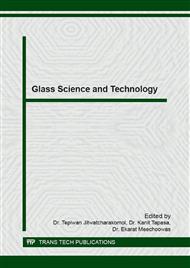p.18
p.23
p.28
p.32
p.37
p.43
p.51
p.57
p.62
Phase Change Properties of Chalcogenide Glasses - Some Interesting Observations
Abstract:
Chalcogenide glasses switches from a high-resistance (OFF) state to a low-resistance (ON) state at a threshold voltage (Vth) under high electric fields. This electrical switching is of two types: (i) Threshold switching and (i) memory switching. Threshold switching device revert back to the OFF state immediately upon the removal of the applied voltage, whereas a memory device retains the ON state even after the removal of the applied voltage. Due to Joule heating, a filament is formed between the electrodes and the current is confined within this filament and there is an increase in current density. This increases the temperature inside the filament and there is a transition from high resistive amorphous/glass phase to a low resistive crystalline phase in memory switching materials. In the threshold switching glasses electronic processes like space charge, Poole-Frenkel effect, etc., are responsible. The structural transitions are irreversible whereas the electronic processes are reversible and hence the threshold glasses regain their original state (OFF) and memory glasses remain in the ON state.Interestingly, differential scanning calorimetric studies (DSC) show that both the threshold and memory switching glasses exhibit crystallization (structural transition). Accordingly, glasses which crystallize upon heating should exhibit memory switching behaviour. But the switching experiments indicate that among the glasses which undergo structural transition (crystallization) some show threshold switching and some show memory switching. To understand this, Cu-As-Se, Al-As-Te, Ge-As-Se-Te, Al-As-Se-Te glasses were thermally crystallized under vacuum in two ways: (i) by annealing at their respective crystallization temperatures (Tc) and (ii) heated up to their melting temperatures (Tm) and cooled back to room temperature. Interestingly, most of the threshold switching glasses shows amorphous nature or a huge amorphous background with crystalline peaks when cooled from their melting temperatures. The memory switching glasses crystallize in both the cases.We propose that both threshold and memory glasses undergo phase change and the crystalline phases formed from the melt state are responsible for switching to occur. Hence, at the time of switching the sample in between the electrodes undergo phase change by glass → melt → crystal transformation and not by the direct glass → crystal transformation.
Info:
Periodical:
Pages:
37-42
Citation:
Online since:
July 2016
Authors:
Price:
Сopyright:
© 2016 Trans Tech Publications Ltd. All Rights Reserved
Share:
Citation:


